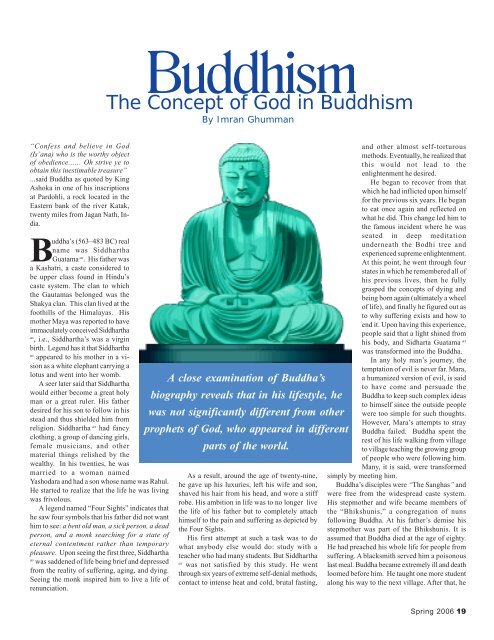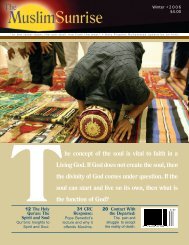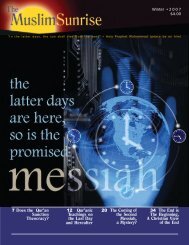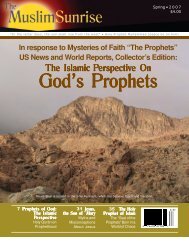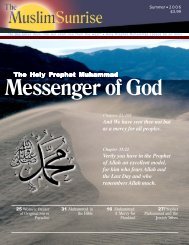Create successful ePaper yourself
Turn your PDF publications into a flip-book with our unique Google optimized e-Paper software.
Buddhism<strong>The</strong> Concept of God in BuddhismBy Imran Ghumman“Confess and believe in God(Is’ana) who is the worthy objectof obedience…… Oh strive ye toobtain this inestimable treasure”...said Buddha as quoted by KingAshoka in one of his inscriptionsat Pardohli, a rock located in theEastern bank of the river Katak,twenty miles from Jagan Nath, India.Buddha’s (563–483 BC) realname was SiddharthaGuatama as . His father wasa Kashatri, a caste considered tobe upper class found in Hindu’scaste system. <strong>The</strong> clan to whichthe Gautamas belonged was theShakya clan. This clan lived at thefoothills of the Himalayas. Hismother Maya was reported to haveimmaculately conceived Siddharthaas, i.e., Siddhartha’s was a virginbirth. Legend has it that Siddharthaasappeared to his mother in a visionas a white elephant carrying alotus and went into her womb.A seer later said that Siddharthawould either become a great holyman or a great ruler. His fatherdesired for his son to follow in hisstead and thus shielded him fromreligion. Siddhartha as had fancyclothing, a group of dancing girls,female musicians, and othermaterial things relished by thewealthy. In his twenties, he wasmarried to a woman namedYashodara and had a son whose name was Rahul.He started to realize that the life he was livingwas frivolous.A legend named “Four Sights” indicates thathe saw four symbols that his father did not wanthim to see: a bent old man, a sick person, a deadperson, and a monk searching for a state ofeternal contentment rather than temporarypleasure. Upon seeing the first three, Siddharthaaswas saddened of life being brief and depressedfrom the reality of suffering, aging, and dying.Seeing the monk inspired him to live a life ofrenunciation.A close examination of Buddha’sbiography reveals that in his lifestyle, hewas not significantly different from otherprophets of God, who appeared in differentparts of the world.As a result, around the age of twenty-nine,he gave up his luxuries, left his wife and son,shaved his hair from his head, and wore a stiffrobe. His ambition in life was to no longer livethe life of his father but to completely attachhimself to the pain and suffering as depicted bythe Four Sights.His first attempt at such a task was to dowhat anybody else would do: study with ateacher who had many students. But Siddharthaaswas not satisfied by this study. He wentthrough six years of extreme self-denial methods,contact to intense heat and cold, brutal fasting,and other almost self-torturousmethods. Eventually, he realized thatthis would not lead to theenlightenment he desired.He began to recover from thatwhich he had inflicted upon himselffor the previous six years. He beganto eat once again and reflected onwhat he did. This change led him tothe famous incident where he wasseated in deep meditationunderneath the Bodhi tree andexperienced supreme enlightenment.At this point, he went through fourstates in which he remembered all ofhis previous lives, then he fullygrasped the concepts of dying andbeing born again (ultimately a wheelof life), and finally he figured out asto why suffering exists and how toend it. Upon having this experience,people said that a light shined fromhis body, and Sidharta Guatama aswas transformed into the Buddha.In any holy man’s journey, thetemptation of evil is never far. Mara,a humanized version of evil, is saidto have come and persuade theBuddha to keep such complex ideasto himself since the outside peoplewere too simple for such thoughts.However, Mara’s attempts to strayBuddha failed. Buddha spent therest of his life walking from villageto village teaching the growing groupof people who were following him.Many, it is said, were transformedsimply by meeting him.Buddha’s disciples were “<strong>The</strong> Sanghas” andwere free from the widespread caste system.His stepmother and wife became members ofthe “Bhikshunis,” a congregation of nunsfollowing Buddha. At his father’s demise hisstepmother was part of the Bhikshunis. It isassumed that Buddha died at the age of eighty.He had preached his whole life for people fromsuffering. A blacksmith served him a poisonouslast meal. Buddha became extremely ill and deathloomed before him. He taught one more studentalong his way to the next village. After that, heSpring <strong>2006</strong> 19


